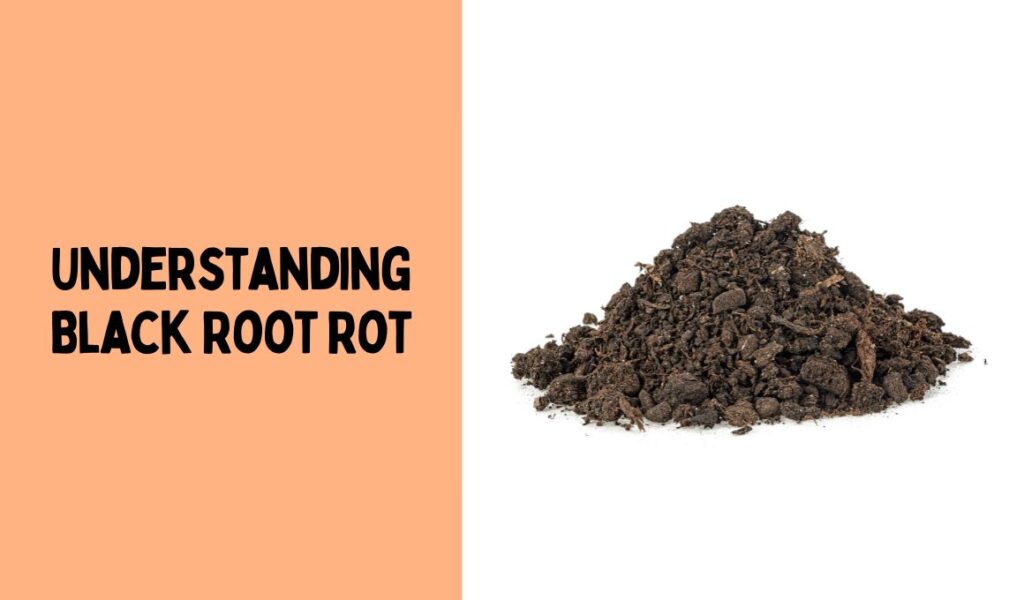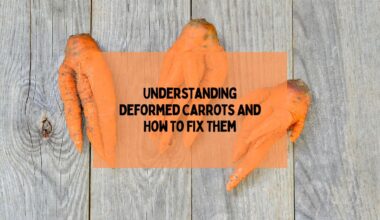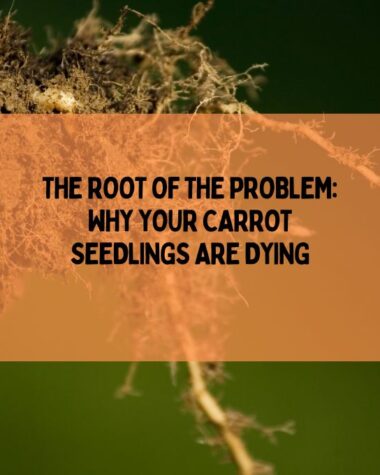Carrot black root rot is a severe fungal disease that affects carrots, one of the most important vegetables in the world. Carrots are highly nutritious and rich in vitamins, minerals, and fiber. People of all ages consume them, which is essential to a healthy diet.
Carrot black root rot is a severe disease that affects carrots, causing the roots to rot and turn black. The disease is common in areas with heavy or poorly drained soils and can cause significant yield losses if left unmanaged.
This article will discuss carrot black root rot, including its symptoms, causes, and prevention methods. I will explain the disease’s causes and the environmental conditions that favor its development.
I will also guide how to prevent the disease from spreading and how to manage infected crops. By the end of the article, you will have a comprehensive understanding of carrot black root rot and be better equipped to protect your carrot crops from this devastating disease.
Understanding Black Root Rot

Carrot black root rot is a soilborne fungal disease that affects carrots. Several fungi, including Thielaviopsis basicola, Phoma spp., and Fusarium spp, cause the disease. These fungi can persist in the soil for many years, making the disease difficult to control once established in a field.
Symptoms of Black Root Rot in Carrots

The symptoms of black root rot in carrots can vary depending on the severity of the infection. In the early stages, infected plants may show wilting, yellowing, and stunted growth. The roots may also appear discolored or water-soaked.
As the disease progresses, the roots may turn black and develop necrotic lesions, making them brittle and prone to breakage. These lesions can also spread to the crown and foliage, causing further damage to the plant. Infected plants may eventually die, leading to a reduction in yield and quality.
Causes of Black Root Rot in Carrots

Several factors can contribute to the development of black root rot in carrots. These include poor soil drainage, overwatering, low soil pH, and the presence of other soilborne pathogens. Contaminated equipment, soil, or plant debris can also spread the disease.
Factors that Increase the Risk of Black Root Rot in Carrots
Several factors can increase the risk of black root rot in carrots. These include planting carrots in fields with a history of the disease, using infected seeds, and planting carrots too closely together. High soil moisture, especially during the early stages of growth, can also increase the risk of infection.
How Black Root Rot Affects Carrot Yield and Quality

Black root rot can significantly impact the yield and quality of carrot crops. Infected plants may produce smaller, misshapen roots, which can reduce the overall yield of the crop.
Carrots affected by black root rot may also be more susceptible to secondary infections by other pathogens, further reducing their quality and shelf life. In severe cases, infected carrots may be unsuitable for sale or consumption, leading to significant economic losses for growers.
Related Read
- The Ultimate Guide To Cucumber Pests and Diseases
- How to Find, Prevent, and Treat Zucchini Plant Problems?
- 10 Tomato Diseases – How to Recognize, Treat, and Prevent?
Diagnosing Black Root Rot

Black root rot is a severe disease that can affect carrots, leading to significant losses in yield and quality. Early detection and proper diagnosis are essential for effective disease management.
This section will discuss the tools and techniques for diagnosing black root rot in carrots and how to differentiate it from other carrot diseases and pests.
Tools and Techniques for Diagnosing Black Root Rot in Carrots
There are several tools and techniques for diagnosing black root rot in carrots. These include:
- Visual inspection: A visual inspection of the plants and roots can help detect the symptoms of black root rot. Infected plants may show wilting, yellowing, stunted growth, and black, necrotic lesions on the roots.
- Laboratory analysis: Laboratory analysis can help confirm the presence of the fungus causing black root rot. This can include soil and plant tissue testing, pathogen isolation, and identification.
- Molecular techniques: Molecular techniques, such as polymerase chain reaction (PCR), can help detect the presence of the fungus causing black root rot more accurately and quickly.
How to Differentiate Black Root Rot from Other Carrot Diseases and Pests
Several other carrot diseases and pests can cause symptoms similar to black root rot. These include nematodes, fungal leaf blights, and bacterial soft rot.
To differentiate black root rot from other diseases and pests, it is essential to consider the following:
- Symptoms: Black root rot typically causes wilting, yellowing, stunted growth, and black, necrotic lesions on the roots. Other diseases and pests may cause different symptoms.
- Timing: Black root rot can affect carrots at any growth stage, while other diseases and pests may be more prevalent at specific stages.
- Environmental factors: Some diseases and pests may be more prevalent under specific environmental conditions, such as high humidity or low soil pH.
The Importance of Timely and Accurate Diagnosis
Timely and accurate diagnosis of black root rot is essential for effective disease management. Early detection can help prevent the spread of the disease and minimize its impact on crop yield and quality.
Accurate diagnosis can also help growers implement the most effective disease management strategies, such as crop rotation, soil management, and fungicide treatments.
Also, Read
- What To Do About Powdery Mildew On Carrot Crops?
- Controlling The Yellowing Of Aster And Carrots – Carrot Crops
- The Management Of Carrot Cotton Root Rot And Its Treatment
Preventing Black Root Rot

Black root rot is a devastating disease that can significantly impact carrot yield and quality. Preventing the disease is essential for maintaining a healthy crop and minimizing losses.
This section will discuss cultural practices, crop rotation, soil management strategies, proper irrigation and drainage practices, and the role of fungicides and other chemical treatments in preventing black root rot in carrots.
Cultural Practices to Prevent Black Root Rot in Carrots
Several cultural practices can help prevent black root rot in carrots. These include:
- Sanitation: Regularly cleaning and disinfecting tools, equipment, and storage facilities can help prevent the spread of the disease.
- Proper plant spacing: Proper plant spacing can improve air circulation and reduce moisture, which can help prevent the development of black root rot.
- Use of disease-resistant cultivars: Using disease-resistant cultivars can help reduce the risk of black root rot in carrots.
Crop Rotation and Its Role in Preventing Black Root Rot

Crop rotation can help prevent the buildup of soil-borne pathogens, including the fungus causing black root rot. Rotating crops with non-host plants can help reduce the risk of disease development.
Rotating carrots with non-host crops such as corn, beans, or wheat for at least two years is recommended.
Soil Management Strategies to Reduce the Risk of Black Root Rot
Soil management strategies can help reduce the risk of black root rot in carrots. These include:
- Proper soil pH: Maintaining a pH level between 6.0 and 6.5 can help reduce the risk of black root rot.
- Organic matter management: Managing organic matter can help improve soil structure and increase soil nutrient availability, reducing the risk of black root rot.
Proper Irrigation and Drainage Practices to Prevent Black Root Rot
Proper irrigation and drainage practices can help prevent the development of black root rot by reducing soil moisture.
Overwatering can create a favorable environment for the fungus development causing black root rot. It is recommended to rinse carrots only when necessary and to ensure proper drainage.
The Role of Fungicides and Other Chemical Treatments in Preventing Black Root Rot
Fungicides and other chemical treatments can be used to prevent the development of black root rot in carrots.
Fungicides can be applied as a preventative measure or treatment after the disease has been identified. However, the use of chemical treatments should be used in conjunction with other preventive measures and should be used judiciously.
Treating Black Root Rot

Black root rot is a fungal disease that can cause significant damage to carrot crops. Although prevention is the best approach, prompt detection and treatment are essential for managing the disease.
This section will discuss fungicidal treatments, other treatments, and management strategies for black root rot in carrots and the importance of early detection and treatment.
Fungicidal Treatments for Black Root Rot in Carrots
Fungicides can be effective in controlling black root rot in carrots. Fungicides containing active ingredients such as azoxystrobin, boscalid, fludioxonil, and pyraclostrobin are effective against the fungus causing black root rot.
However, fungicides should be used judiciously and with other management strategies.
Other Treatments and Management Strategies for Black Root Rot
Several other treatments and management strategies can be used to control black root rot in carrots. These include:
- Soil solarization involves covering the soil with a clear plastic tarp to trap heat and kill soil-borne pathogens, including the fungus causing black root rot.
- Biocontrol agents: Biocontrol agents, such as Trichoderma harzianum and Bacillus subtilis, can control black root rot in carrots.
- Organic amendments: Organic amendments such as compost and manure can improve soil health and reduce the risk of black root rot.
The Importance of Early Detection and Treatment
Early detection and treatment are crucial for managing black root rot in carrots. Symptoms of black root rot can easily be confused with other carrot diseases, making accurate diagnosis important.
If black root rot is suspected, soil and plant tissue samples should be taken for laboratory analysis to confirm the disease.
Fungicidal treatments should be applied immediately after the disease has been identified. Other management strategies should also be implemented to reduce the risk of disease development in future crops.
Final Thoughts
Black root rot is a fungal disease that can cause severe damage to carrot crops, affecting yield and quality. Prevention, early detection, and treatment are essential for managing black root rot. Cultural practices such as crop rotation, soil management, and proper irrigation and drainage can reduce the risk of disease development.
Fungicidal treatments and other management strategies, such as soil solarization and biocontrol agents, can also effectively control the disease. However, fungicides should be used judiciously and with other management strategies.
Early detection and treatment are crucial for minimizing losses and maintaining healthy carrot crops. Growers can manage black root rot and produce high-quality carrots by implementing preventive measures and prompt action.
Happy Gardening!







